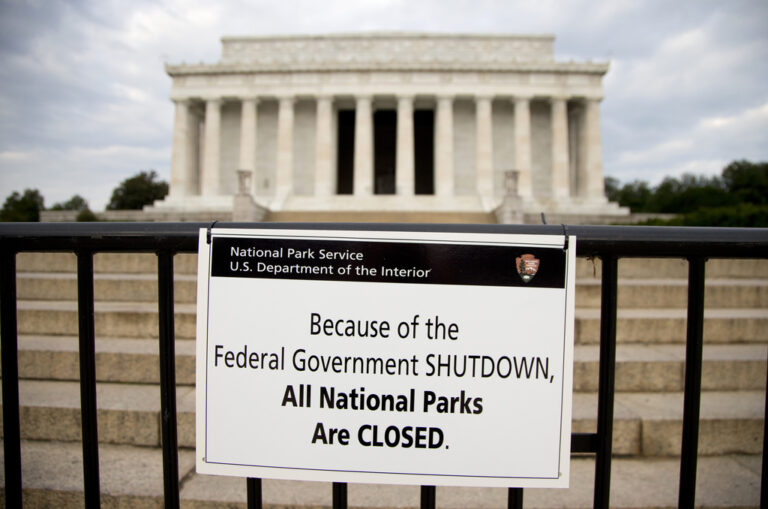WASHINGTON (AP) — The threat of a federal government shutdown suddenly lifted late Saturday as President Joe Biden signed a temporary funding bill to keep agencies open with little time to spare after Congress rushed to approve the bipartisan deal.
The package drops aid to Ukraine, a White House priority opposed by a growing number of GOP lawmakers, but increases federal disaster assistance by $16 billion, meeting Biden’s full request. The bill funds government until Nov. 17.
After chaotic days of turmoil in the House, Speaker Kevin McCarthy abruptly abandoned demands for steep spending cuts from his right flank and instead relied on Democrats to pass the bill, at risk to his own job. The Senate followed with final passage closing a whirlwind day at the Capitol.
“This is good news for the American people,” Biden said in a statement.
He also said the United States “cannot under any circumstances allow American support for Ukraine to be interrupted” and expected McCarthy “will keep his commitment to the people of Ukraine and secure passage of the support needed to help Ukraine at this critical moment.”
It’s been a sudden head-spinning turn of events in Congress after grueling days in the House pushed the government to the brink of a disruptive federal shutdown.
The outcome ends, for now, the threat of a shutdown, but the reprieve may be short-lived. Congress will again need to fund the government in coming weeks risking a crisis as views are hardening, particularly among the right-flank lawmakers whose demands were ultimately swept aside this time in favor of a more bipartisan approach.
“We’re going to do our job,” McCarthy, R-Calif., said before the House vote. “We’re going to be adults in the room. And we’re going to keep government open.”
If no deal was in place before Sunday, federal workers would have faced furloughs, more than 2 million active-duty and reserve military troops would have had to work without pay and programs and services that Americans rely on from coast to coast would have begun to face shutdown disruptions.
“It has been a day full of twists and turns, but the American people can breathe a sigh of relief: There will be no government shutdown,” said Senate Majority Leader Chuck Schumer, D-N.Y.
The package funds government at current 2023 levels until mid-November, and also extends other provisions, including for the Federal Aviation Administration. The package was approved by the House 335-91, with most Republicans and almost all Democrats supporting. Senate passage came by an 88-9 vote.
But the loss of Ukraine aid was devastating for lawmakers of both parties vowing to support President Volodymyr Zelenskyy after his recent Washington visit. The Senate bill included $6 billion for Ukraine, and both chambers came to a standstill Saturday as lawmakers assessed their options.
“The American people deserve better,” said House Democratic leader Hakeem Jeffries of New York, warning in a lengthy floor speech that “extreme” Republicans were risking a shutdown.
For the House package to be approved, McCarthy was forced to rely on Democrats because the speaker’s hard-right flank has said it will oppose any short-term funding measure, denying him the votes needed from his slim majority. It’s a move that is sure to intensify calls for his ouster.
After leaving the conservative holdouts behind, McCarthy is almost certain to be facing a motion to try to remove him from office, though it is not at all certain there would be enough votes to topple the speaker. Most Republicans voted for the package Saturday while 90 opposed.
“If somebody wants to remove me because I want to be the adult in the room, go ahead and try,” McCarthy said of the threat to oust him. “But I think this country is too important.”
The White House was tracking the developments on Capitol Hill and aides were briefing the president, who was spending the weekend in Washington.
Senate Republican leader Mitch McConnell, who has championed Ukraine aid despite resistance from his own ranks, is expected to keep pursuing U.S. support for Kyiv in the fight against Russia.
“I have agreed to keep fighting for more economic and security aid for Ukraine,” McConnell, R-Ky., said before the vote.
Late at night, the Senate stalled when Sen. Michael Bennet, D-Colo., held up the vote, seeking assurances Ukraine funds would be reconsidered.
“I know important moments are like this, for the United States, to lead the rest of the world,” Bennet said, noting his mother was born in Poland in 1938 and survived the Holocaust. “We can’t fail.”
The House’s quick pivot comes after the collapse Friday of McCarthy’s earlier plan to pass a Republican-only bill with steep spending cuts up to 30% to most government agencies and strict border provisions that the White House and Democrats rejected as too extreme. A faction of 21 hard-right Republican holdouts opposed it.
“Our options are slipping away every minute,” said one senior Republican, Rep. Mario Diaz-Balart of Florida.
The federal government had been heading straight into a shutdown that posed grave uncertainty for federal workers in states all across America and the people who depend on them — from troops to border control agents to office workers, scientists and others.
Families that rely on Head Start for children, food benefits and countless other programs large and small were confronting potential interruptions or outright closures. At the airports, Transportation Security Administration officers and air traffic controllers had been expected to work without pay, but travelers could have faced delays in updating their U.S. passports or other travel documents.
The White House has brushed aside McCarthy’s overtures to meet with Biden after the speaker walked away from the debt deal they brokered earlier this year that set budget levels.
Catering to his hard-right flank, McCarthy had made multiple concessions including returning to the spending limits the conservatives demanded back in January as part of the deal-making to help him become the House speaker.
But it was not enough as the conservatives insisted the House follow regular rules, and debate and approve each of the 12 separate spending bills needed to fund the government agencies, typically a months-long process. In the Senate, all the no votes against the package came from Republicans.
McCarthy’s chief Republican critic, Rep. Matt Gaetz of Florida, has warned he will file a motion calling a vote to oust the speaker.
Some of the Republican holdouts, including Gaetz, are allies of former President Donald Trump, who is Biden’s chief rival in the 2024 race. Trump has been encouraging the Republicans to fight hard for their priorities and even to “shut it down.”
At an early closed-door meeting at the Capitol, several House Republicans, particularly those facing tough reelections next year, urged their colleagues to find a way to prevent a shutdown.
“All of us have a responsibility to lead and to govern,” said Republican Rep. Mike Lawler of New York.
The lone House Democrat to vote against the package, Rep. Mike Quigley of Illinois, the co-chair of the Congressional Ukraine Caucus, said, “Protecting Ukraine is in our national interest.”
___
Associated Press writers Colleen Long and Mary Clare Jalonick contributed to this report.
WASHINGTON — With a midnight deadline approaching, Congress was working to avert a government shutdown that would disrupt many services, squeeze federal employees and roil politics.
The threat of a shutdown was easing Saturday after House approval of a plan to keep agencies open until Nov. 17.
The Senate was meeting late in the evening after Speaker Kevin McCarthy, R-Calif., dropped demands for steep spending cuts and relied on Democratic votes for House passage.
House Republicans, fueled by hard-right demands for lower spending, had been forcing a confrontation over federal spending.
In a shutdown, some government entities would be exempt — Social Security checks, for example, would still go out — and other functions would be severely curtailed. Federal agencies would cease all actions deemed nonessential, and many of the federal government’s roughly 2 million employees, as well as 2 million active-duty military troops and reservists, would not receive paychecks.
A look at what could happen in the event of a shutdown Sunday.
WHAT IS A GOVERNMENT SHUTDOWN?
A shutdown happens when Congress fails to pass some type of funding legislation that is signed into law by the president. Lawmakers are supposed to pass 12 different spending bills to fund agencies across the government, but the process is time-consuming. They often resort to passing a temporary extension, called a continuing resolution or CR, to allow the government to keep operating.
When no funding legislation is enacted, federal agencies must stop all nonessential work and would not send paychecks as long as the shutdown would last.
Although employees deemed essential to public safety such as air traffic controllers and law enforcement officers still have to report to work, other federal employees are furloughed. Under a 2019 law, those workers are slated to receive backpay once the funding impasse is resolved.
WHEN WOULD A SHUTDOWN BEGIN AND HOW LONG COULD IT LAST?
Government funding expires Sunday, Oct. 1, the start of the federal budget year. A shutdown would effectively begin at 12:01 a.m. Sunday if Congress was unable to pass a funding plan that the president could sign into law.
There were fears that a potential stoppage could last weeks.
WHO DOES A SHUTDOWN AFFECT?
Millions of federal workers would face delayed paychecks, including many of the roughly 2 million military personnel and more than 2 million civilian workers across the nation. For many workers, the first payday they would miss is Oct. 13.
Nearly 60% of federal workers are stationed in the Department of Defense, Veterans Affairs and Homeland Security.
While the military’s active-duty troops and reservists would continue to work, more than half of the Department of Defense’s civilian workforce — roughly 440,000 people — would be furloughed.
Across federal agencies, workers are stationed in all 50 states and have direct interaction with taxpayers — from Transportation Security Administration agents who operate security at airports to Postal Service workers who deliver mail.
Transportation Secretary Pete Buttigieg has said new training for air traffic controllers would have to be halted and an additional 1,000 controllers in the midst of training would have to be furloughed.
People applying for government services like clinical medical trials, firearm permits and passports could see delays if there was a shutdown.
Head Start programs serving more than 10,000 disadvantaged children would immediately lose federal funding. National parks would close on Monday.
Some federal offices would have to close or face shortened hours during a shutdown.
Businesses closely connected to the federal government, such as federal contractors or tourist services around national parks, could see disruptions and downturns.
Lawmakers warned that a shutdown could rattle financial markets. Goldman Sachs estimated that a shutdown would reduce economic growth by 0.2% every week it lasted, but growth would then bounce back after the government reopens.
Others say any disruption in government services would have far-reaching impacts because it would shake confidence in the government to fulfill its basic duties.
WHAT ABOUT COURT CASES, THE WORK OF CONGRESS AND PRESIDENTIAL PAY?
The president and members of Congress would continue to work and get paid. Any members of their staff who were not deemed essential would be furloughed.
The Supreme Court, which begins its new term Monday, would be unaffected by a short shutdown because it can draw on a pot of money provided by court fees, including charges for filing lawsuits and other documents, court spokeswoman Patricia McCabe said.
The rest of the federal judiciary would operate normally for at least the first two weeks of October, said Peter Kaplan, a spokesman for the judiciary.
Even in a longer shutdown, the entire judiciary would not shut down, and decisions about what activities would continue would be made by each court around the country. The justices and all federal judges would continue to be paid because of the constitutional prohibition on reducing judges’ pay during their tenure, according to the Congressional Research Service.
Funding for the three special counsels appointed by Attorney General Merrick Garland would not be affected by a government shutdown because they are paid for through a permanent, indefinite appropriation, an area that has been exempted from shutdowns in the past.
That would mean that the two federal cases against Donald Trump, the former president, as well as the case against Hunter Biden, the son of President Joe Biden, would not be interrupted. Trump has demanded that Republicans defund the prosecutions against him as a condition of funding the government, declaring it their “last chance” to act.
HAS THIS HAPPENED BEFORE?
Before the 1980s, lapses in government funding did not result in government operations significantly shuttering. But then-Attorney General Benjamin Civiletti, in a series of legal opinions in 1980 and 1981, argued that government agencies cannot legally operate during a funding gap.
Federal officials have since operated under an understanding they can make exemptions for functions that are “essential” for public safety and constitutional duties.
Since 1976, there have been 22 funding gaps, with 10 of them leading to workers being furloughed. But most of the significant shutdowns have taken place since Bill Clinton’s presidency, when then-Speaker Newt Gingrich. R-Ga., and his conservative House majority demanded budget cuts.
The longest government shutdown happened between 2018 and 2019 when then-President Trump and congressional Democrats entered a standoff over his demand for funding for a border wall. The disruption lasted 35 days, through the holiday season, but was also only a partial government shutdown because Congress had passed some appropriations bills to fund parts of the government.
WHAT DOES IT TAKE TO END A SHUTDOWN?
It’s the responsibility of Congress to fund the government. The House and Senate would both have to agree to fund the government, and the president has to sign the legislation into law.
Congress often has relied on a continuing resolution to provide stopgap money to open government offices at current levels as budget talks are underway. Money for pressing national priorities, such as emergency assistance for victims of natural disasters, is often attached to a short-term bill.
___
Associated Press writers Lolita Baldor, Mark Sherman, Heather Hollingsworth, Fatima Hussein, Lindsay Whitehurst, Josh Boak, Kevin Freking, and Lisa Mascaro contributed to this report.








